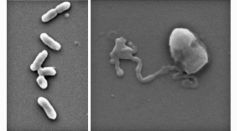NANOTECHNOLOGY

Nanoplastics Everywhere: Scientists Find Small Plastic Particles in Various Ecosystems

Nanoparticle Drug Delivery Could Boost Bowel Cancer Odds

AR/VR Glasses of the Future Need Not Be Bulky, Bug-Eyed with New Technology
Quantum Tech One Step Closer With New Single Photon Switch

Corn Waste Finds New Purpose in Water Treatment Studies
Nanocages Could Live to Safer Lives for Soldiers, Athletes, Motorists – Study

DNA Nanorobots Created in Minutes Could Be Used for Drug Delivery and Pathogen Detection Inside the Body
Will New Spintronics Device Produce More Powerful Computer Processors?

Muon Anomaly: How A 'Last Hope' Effort Revolutionizes Physics

Self-Assembling Nanofiber That Limits Damage of Inflammatory Diseases Developed
New Graphene 3D Printing Technique Makes Feasible Water Filters
Ultrasound Waves Create Never-Repeating Pattern in Carbon

Nanothin Layer on Wound Dressings Kills 99% of Antibiotic-Resistant Bacteria
New Nanothin Coating Kills Superbugs, Fungi, Bacteria: Here's How It Works
Most Popular

Ocean Acidification, Marine pH Change, and CO2 Absorption: How Coral Reef Damage and Shellfish and Plankton Impacts Threaten Marine Life

Dark Matter Explained: What We Know, What We Don't, and How It Shapes Cosmic Structure

Memory and Learning: How the Brain Stores, Retrieves, and Forgets Information

Water, Carbon, and Nitrogen Cycles: How Biogeochemical Cycles Sustain Earth's Ecosystems




